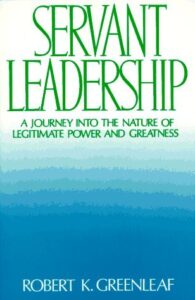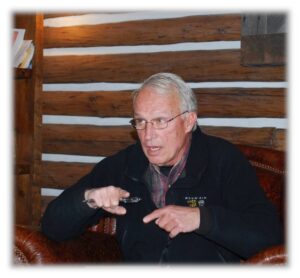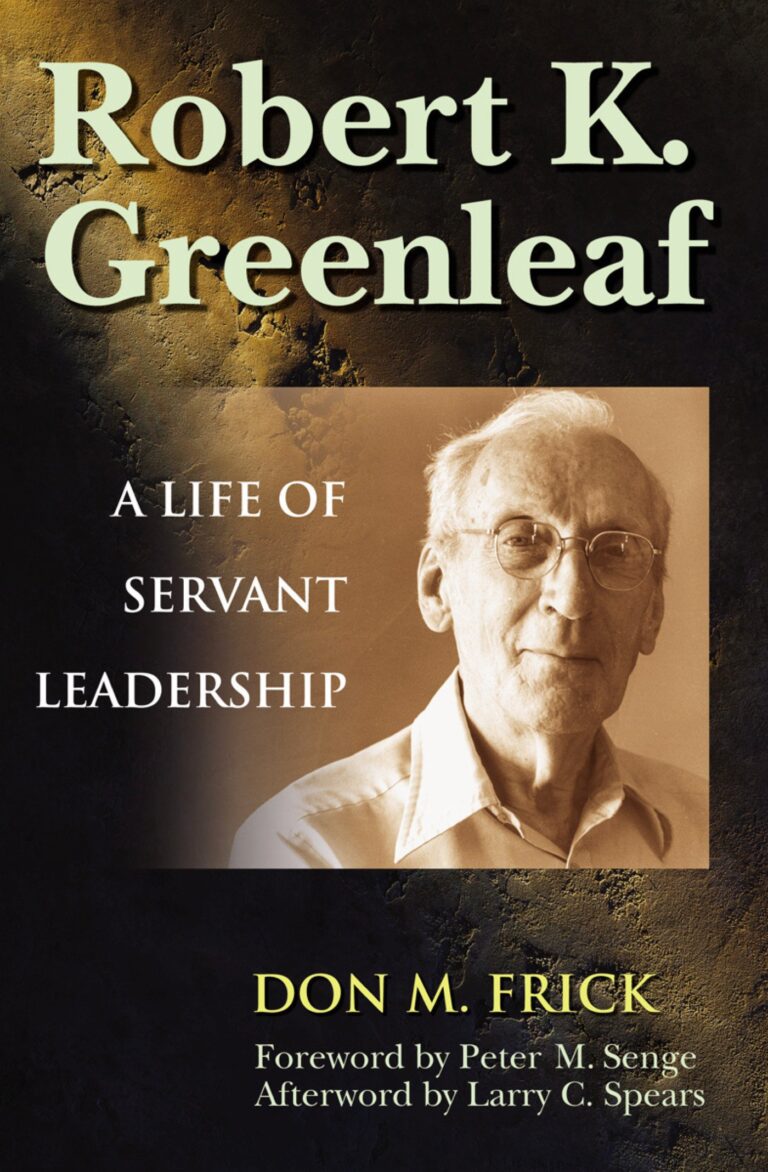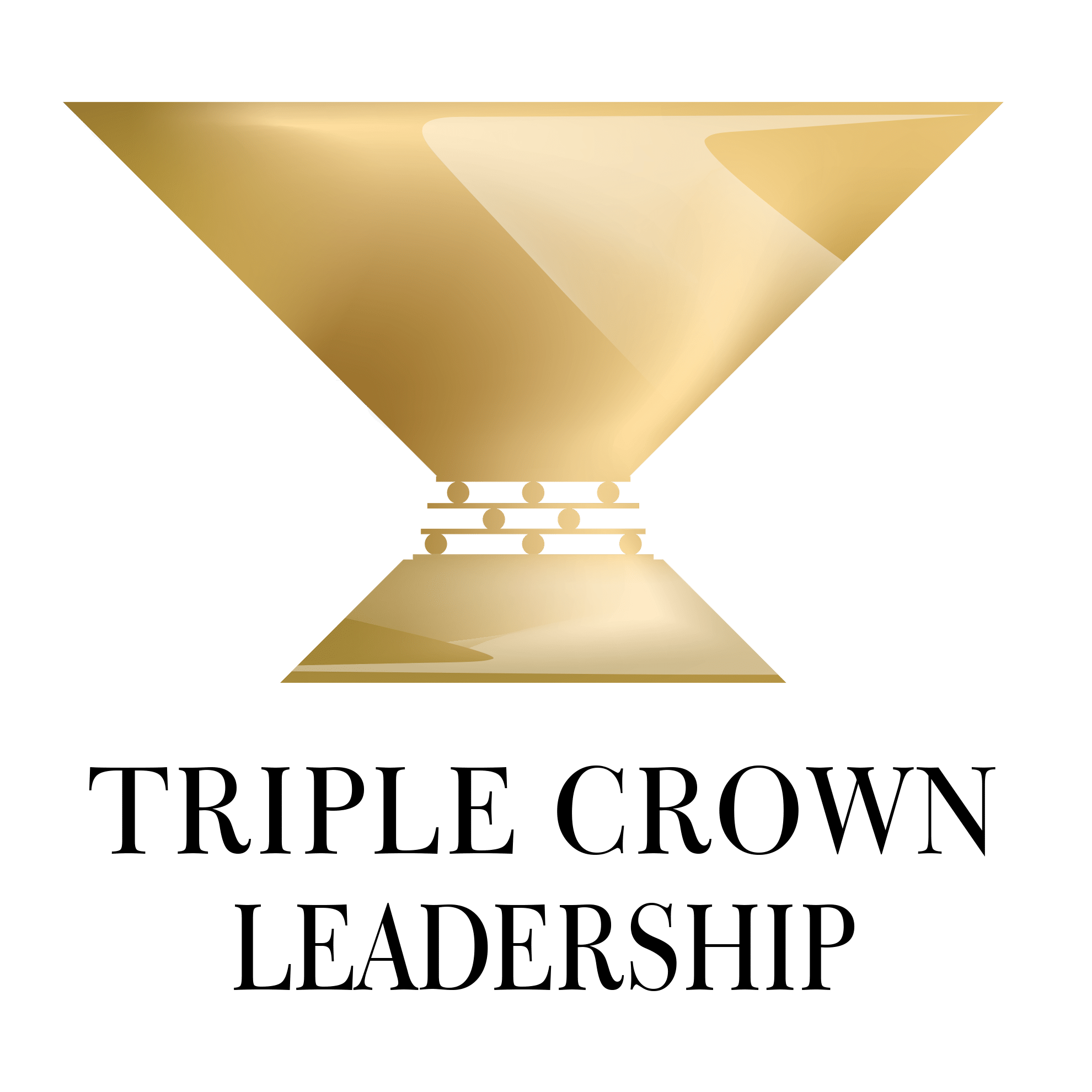Robert Greenleaf was the founder of the servant-leadership movement. But who was this self-effacing man? Why did Stephen R. Covey say,
“… I have found Robert Greenleaf’s teachings on servant leadership to be so enormously inspiring, so uplifting, so ennobling.”
With no grand title or celebrity, how did Greenleaf, a self-described introvert, create this world-wide servant-leadership movement? Peter Senge said,
“For many years, I simply told people not to waste their time reading all the other managerial and leadership books. If you are really serious about the deeper territory of true leadership, I would say, read Greenleaf.”
Greenleaf’s ideas were counterintuitive, even antithetical to the established paradigms of leadership. Yet, numerous organizations worldwide reached out to hear his thoughts including leading businesses, nonprofits, educational institutions, and religious organizations. How and why did this new philosophy of leadership come into being? It started with a flash of insight.
Journey to the East

In 1968, Greenleaf and his wife, Esther, were driving from the Prescott College in Arizona. He had just facilitated a series of voluntary seminars on leadership for freshmen. He confessed to Esther that it was a total failure. The faculty resented the outsider-led seminars and tried to sabotage them. The Vietnam War was going badly. The tension across the country was high as many citizens questioned the credibility of our country’s leaders. Trust in leaders was plummeting.
Then in the car, Greenleaf recalled reading Hermann Hesse’s novel, Journey to the East. It’s the fictional story of a band of men on a grand journey. Leo accompanies the party as their servant, sustaining the group with his spirit, song, and presence. Suddenly, Leo disappears, and the group soon abandons the journey. Years later, the narrator finds Leo and is taken to the Order that had sponsored the journey. He discovers that Leo was the head of the Order, “its guiding spirit, a great and noble leader.”
As Don Frick describes in his wonderful 2004 biography, Robert K. Greenleaf: A Life of Servant Leadership:
“Suddenly, a two-word phrase popped into [Greenleaf’s] mind: ‘servant-leader.’ That said it all. It described what he was trying to communicate to the people at Prescott; they should all lead by serving each other. True servants operate out of love. True leaders seek to serve those who are led. People who serve are, in fact, leaders and followers. This one paradoxical phrase seemed to sum up the goal of his entire career: to lead through service and encourage people and institutions to serve first. In fact, it described—in spite of all his personal foibles and internal contradictions—the underlying theme of his whole life.”
The Servant as Leader
Once home, Greenleaf began writing an essay he titled “The Servant as Leader.” In 1970, he printed a few hundred copies in pamphlet form and sent them out to friends and colleagues. From that humble beginning, a new philosophy of leadership was launched. For the next twenty years, Greenleaf would write more essays on the servant-leader theme, see them consolidated into a book, and speak and teach about servant leadership around the world.
But flashes of insight don’t come magically out of the ether. They emerge from deep immersion in a subject, where many varying thoughts ruminate and percolate around one’s brain until some synapses in the mind cross and overlap in new and unique ways. What were the sourcing springs of Greenleaf’s servant leadership journey?
Born in Terre Haute, Indiana, Greenleaf was a typical “Hoosier.” These Midwesterners were thrifty people with good humor and little pretense, who stood up against bullies, corruption, and arrogance. Robert’s mother struggled with alcohol. His father, George, was a huge influence on young Robert. George was a “wizard” mechanic and machinist with high integrity, gentle unless aroused by the misdeeds of bad men. He was a community steward, a union man, politically active locally. George took Robert on tours of factories on Sundays. He became a school board trustee and an Indiana state factory inspector. Greenleaf’s father was his original model for a servant leader.
As a teen, Robert worked in many jobs: a shoe store, machinist’s firm, electrical company, and construction firm. He grew to know the hard-working, laboring men of the Midwest and learned to respect their skills. He was an introvert and learned to be an excellent listener. Like his father, he stood up against injustices in high school, college, and among the among the working folks.

Leadership Derailers Assessment
Take this assessment to identify what’s inhibiting your leadership effectiveness. It will help you develop self-awareness and identify ways to improve your leadership.
Making an Impact
After a short stint at an engineering school, Greenleaf enrolled at Carlton College, a Christian college in Minnesota. He didn’t distinguish himself academically, barely amassing enough credits to graduate. But one professor, Oscar Helming, had a marked influence on him. He encouraged his students to “work within a big organization to change it from inside.” That calling appealed to Greenleaf.
As Frick said in his Greenleaf bio,
“For him, a large organization was a platform for living out a peculiar destiny. After working for a construction company, he had no desire to be a building contractor. After three years as an apprentice in a machine shop, he had no drive to manage a factory. ‘By the time I got to college,” [Greenleaf] said, ‘I was through with running things. That was not the way I wanted to live my life … [I] had been captured by the idea of making an impact on society from within a large organization.’”
The AT&T Years: How Robert Greenleaf Created Servant Leadership
After college, Greenleaf was hired by an AT&T subsidiary in Ohio. At the time, AT&T was one of the largest businesses in the country with a huge employee base. But Greenleaf said, “I always had my own agenda, from my first day to my last.” His passion was “to effect change within the organization.”
Greenleaf spent several years working high on telephone poles in all kinds of weather. Because of his quickly learned knowledge of his job, he was promoted to supervise Technical Training for employees, especially first-line supervisors through foreman conferences.
Greenleaf was 23 and his class participants often ranged in age from 30 to 63. He called this “the most formative experience of my adult life.” This was AT&T’s first formal attempt at management training. Greenleaf became an excellent teacher and developed innovative learning techniques.
Frick quotes Greenleaf:
“I learned much from these men. They were in the spot where the buck stops. The elaborate executive hierarchy above them thought their great thoughts about what ought to be done. What actually got done was what these fellows were able (and, to some extent, willing) to do. This was my graduate education. And, for the kind of career I had, I cannot imagine a better one.”
Greenleaf was then transferred to AT&T headquarters in Manhattan with a broad portfolio to conduct research in all phases of personnel management. His first assignment was to investigate hiring policies and assessment techniques.

Personal Values Exercise
Complete this exercise to identify your personal values. It will help you develop self-awareness, including clarity about what’s most important to you in life and work, and serve as a safe harbor for you to return to when things are tough.
The Quaker Influence on Robert Greenleaf
In New York, Robert and Esther joined the Society of Religious Friends and begin an intense study of Quaker history and practice. Quakers avoided hierarchical structures, elicited participation from all members, replaced professional clerics with lay leaders, practiced consensus decision-making, and often engaged in long periods of silence during their Christian devotionals. This Quaker experience deeply influenced Greenleaf.
Greenleaf and Esther developed “Receptive Listening” courses and conducted them for AT&T employees and managers for years. In the early 1960s, due to his extensive work covering management and leadership, Greenleaf was invited to be a visiting lecturer at Harvard Business School, Dartmouth, and the Sloan School of Management at MIT. He also began consulting for IBM, Alcoholics Anonymous, the Ford Foundation in India, and the National Council of Churches.
In 1964, after 38 impactful years at AT&T, Greenleaf took early retirement. He had unobtrusively reduced his staff from 20 to one person over several years. AT&T’s senior leaders were stunned to learn he wished to leave. He was called “a legend at AT&T.”
The Greenleaf Center for Servant Leadership
But depart, he did. Numerous universities and consulting organizations offered him high-level positions, but he declined them all, wanting to work only with people he enjoyed and at his own pace. He set up the Center for Applied Ethics, later called the Greenleaf Center for Servant Leadership (now located at Seton Hall University). This nonprofit was the foundation for his consulting and subsequent writing. Clients included dozens of organizations: Business Roundtable, Dartmouth College, Harvard Divinity School, Lilly Endowment, Mead Corp., Sloan School of Management, and more. He taught at Fresno State College and the University of Virginia.
Greenleaf continued his extensive writing, including: “Trustees as Servants,” “The Institution as Servant,” “The Leadership Crisis: A Message for College and University Faculty,” and “Teacher as Servant.” In 1977, Paulist Press published many of these slightly revised essays as a book (since released in later editions), Servant Leadership: A Journey into the Nature of Legitimate Power and Greatness. After March 1979, all book royalties went to the Greenleaf Center. Greenleaf didn’t wish to become wealthy.

Combining “Servant” and “Leadership”
So, what were the essential precursors that led to Greenleaf’s flash of insight conjoining “servant” and “leadership”? Throughout his life, Greenleaf was an avid and lifelong learner. He took every management class AT&T offered him. Greenleaf attended many traditional and esoteric lectures and seminars from a wide range of speakers. He was an ardent reader.
Over the years, AT&T gave him the freedom to explore any and all subjects related to management and leadership. He absorbed them all. In the process, he came to believe that “the power-centered, authoritarian leadership style” so prominent in U.S. institutions was not working. Greenleaf was a lifelong seeker of a better way.
Greenleaf shunned titles, recognition, and wealth, preferring to operate behind the scenes. He was a ghostwriter for the speeches of AT&T executives and presidents. He declined promotions at AT&T. Greenleaf didn’t want to be viewed as a member of the “country club set.” He deadpanned, “county club was a swear word in our family.”
He avoided chairing committees, preferring the influential role of secretary instead. During World War II he was a regular speaker at the Air War College. He created leadership manuals for AT&T and outside organizations. His last and longtime title at AT&T was Director of Management Research, defined loosely as “whatever he was doing.”
Greenleaf was humble, not wanting to draw attention to himself. Larry Spears, longtime Executive Director of the Greenleaf Center, called him a “quiet eccentric.” Greenleaf loved to teach by asking questions, the Socratic method. As a student of Quaker practices, he loved reflection and sanctuary. But he was also curious and playful, dancing in the kitchen with Esther, and he loved cats.

Alignment Scorecard
When organizations aren’t aligned, it can reduce performance dramatically and cause frustration and dysfunction. With this Alignment Scorecard, you can assess your organization’s level of alignment and make plans for improving it.
“My Shadow”
He had his darker sides, suffering at times from depression, experimenting briefly with LSD when it was legal, and working hard to control a temper when he saw injustices. He once remarked, “I have taken my shadow along. I accept him.”
But Greenleaf learned early from his father and the working people of the Midwest about right and wrong. Greenleaf believed in the “wisdom of everyday people—those sensible, practical, unpretentious folks who got things done.” He was kind and caring. He rejected being a formal, titled leader. He was a servant first. Then, through his ideas, his writing, and his teaching, he became a leader.
Bob’s Introduction to Servant Leadership

Bob Vanourek was fortunate in the late 1970s to work briefly for Jan and Olga Erteszek, the owners of an innovative apparel company. Jan was a friend and trusted colleague of Robert Greenleaf. Knowing Bob’s interest in leadership, Jan gave Bob copies of Greenleaf’s early essays. Those pamphlets transformed Bob’s view of leadership.
Until Bob read Greenleaf, his view of leadership was the traditional one: perhaps caring, but essentially top-down, command-and-control with the leader in charge, (supposedly) knowing all the answers, and motivating people through rewards and punishments. Bob sensed, like Greenleaf did, that such a practice wasn’t right. After reading Greenleaf, Bob set out to become a servant leader.
In the late 1980s, Bob learned Robert Greenleaf was in an assisted-living facility. He and his wife, June, drove hundreds of miles to visit him and pay their respects to this giant leadership thinker. He received them in his humble, kind manner.
Robert Greenleaf died in 1990. We followers celebrate his life and work. Taking his cues from his favorite poet, Robert Frost, and Hermann Hesse, Greenleaf said, “The poem becomes more vivid and real than the poet.” He would have been greatly pleased today that his verses about servant-leadership have become so real for so many of us. He wanted the focus to be on his work, not on himself, once again personifying a “life of servant leadership.”
Tools for You
- Leadership Derailers Assessment to help you identify what’s inhibiting your leadership effectiveness
- Personal Values Exercise to help you determine and clarify what’s most important to you
- Alignment Scorecard to help you assess your organization’s level of alignment
More Articles from Our Series on Servant Leadership
- How to Become a Better Servant Leader
- The Essential Qualities of Servant Leadership
- Unleashing Leaders in Your Organization
- Who Determines If You’re a Leader?
- Why Servant Leaders Outperform Bosses
- Do I Have to Be a Servant Before I Can Lead?
- Why Maximizing Shareholder Value Is Wrong
- The Paradoxes of Servant Leadership
- Boards and Servant Leadership
Postscript: Robert Greenleaf Quotations on Servant Leadership
- “Moral authority is another way to define servant leadership because it represents a reciprocal choice between leader and follower.”
- “One must not be afraid of a little silence. … It is sometimes important to ask—‘In saying what I have in mind will I really improve on the silence?’”
- “Listening, coupled with regular periods of reflection, are essential to the growth of the servant-leader.”
- “A true, natural servant automatically responds to any problem by listening first.”
- “Some of you ought to make careers inside these big institutions and become a force for good—from the inside.”
- “Everywhere there is much complaining about too few leaders. We have too few because most institutions are structured so that only a few—only one at the time—can emerge.”
- “A particular strength of servant-leadership is that it encourages everyone to actively seek opportunities to both serve and lead others, thereby setting up the potential for raising the quality of life throughout society.”
- “In the end, nothing really counts but love and friendship.”

Triple Crown Leadership Newsletter
Join our community. Sign up now and get our monthly inspirations (new articles, announcements, opportunities, resources, and more). Welcome!
Don Frick’s biography, Robert K. Greenleaf: A Life of Servant Leadership, is the primary source for this blog.
+++++++++++++++++++++++
Bob Vanourek and Gregg Vanourek are leadership practitioners, teachers, and award-winning authors. They are co-authors of Triple Crown Leadership: Building Excellent, Ethical, and Enduring Organizations, a winner of the International Book Awards. Check out their Leadership Derailers Assessment or get their monthly newsletter. If you found value in this, please forward it to a friend. Every little bit helps!


